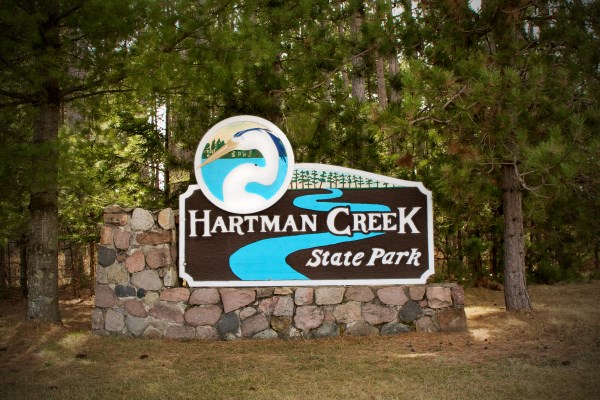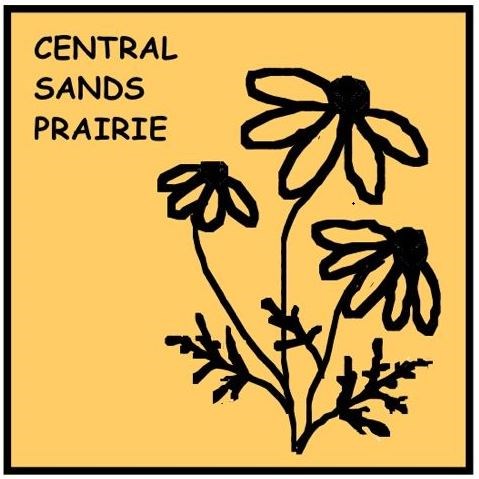HARTMAN CREEK STATE PARK

The events that led up to the establishment of Hartman Creek State Park are examples of the colorful history of the settlement and development of Central Wisconsin. The park's Old Coach Road Trail incorporates part of the stagecoach road that connected Oshkosh and Stevens Point in the 1800s. Many of the early settlers of the Waupaca area may have traveled on this road to reach their homesteads.
One early family, the Allens, had an unintended significant influence on the development of this property into the state park that it is now. In 1874 George Allen and his family owned a farm that eventually became the initial land purchased by the state that became Hartman Creek State Park.
The Allens' house was where the park's maintenance area is now. The farm's primary crop was hops, used mostly for beer making. The Allens had the largest hops house in Waupaca County. The hops were grown to replace hops grown in the east that at the time were devastated by drought. George Allen later switched from hops farming to dairy farming. His son, Merrick, took over operation of the farm in 1880.
The dairy industry was growing in Wisconsin during this time, and some local farmers joined together to form the Spring Hill Creamery Cooperative in 1903. The creamery was built on 1.25 acres that Merrick Allen sold to the co-op. John J. Windfeldt, an award-winning cheese and butter maker, was hired to run the creamery. He bought the creamery as well as an adjoining farm to the south. His apple orchards remain to this day.
In 1925, George W. Allen, Merrick Allen's son, took over ownership of the farm. He turned the farm into a fish hatchery. In 1927, he leased the creamery from Windfeldt and used the basement to raise fingerlings.
During the 1920s George Allen cleared swamps, built several dams and created a private brook trout hatchery. He allowed people to come and fish at the hatchery for a fee. By 1936 he had raised and released 3.5 million trout fingerlings. Due to hardships caused by the Depression and other circumstances, his estate went into foreclosure in 1935.
The Wisconsin Conservation Department bought the property in 1939 for $8,500. The initial purchase of 309 acres included parts of the Allen estate and also the Hartman family estate. The Conservation Department built a dam on the creek and created Allen Lake, named in honor of George W. Allen. They named the property “Hartman Creek State Fish Hatchery.”
The hatchery was used to raise and release smallmouth bass into Wisconsin rivers such as the Kickapoo, Blue and Pecatonica that could no longer support trout due to degradation of the rivers. Improvements of the property started after the State Fish Hatchery was established. The pine plantations that are now mature trees in the park were planted by the Works Progress Administration (WPA) in the early 1940s. In 1950 walleye, northern pike, largemouth bass and trout were added to the hatchery enterprise. By 1960 the hatchery was no longer needed, and the property was turned over to the State Parks and Recreation Division.
With spring-fed lakes abundant with fish, land with pine plantations, apple orchards, fields with wildflowers and natural stands of hardwoods abounding with wildlife, Hartman Creek State Park officially opened on July 22, 1966.
Today, the park consists of about 1,500 acres, including 80 acres of Windfeldt's estate and other properties owned by local families that sold or donated their land to the state.
The campground is in a stand of tall pines and apple trees on a bluff overlooking Allen Lake. Many old logging roads wind through the area. The roads have been converted into hiking trails, and you may retrace the routes followed by Wisconsin's lumberjacks.
http://dnr.wi.gov/topic/parks/name/hartman/history.html

This region is right in the middle of our state, easy to get to from everywhere else. Its biome is sand plains and prairie. The landscape was largely shaped when it sat at the bottom of huge Glacial Lake Wisconsin, which left behind sandy soils and a fairly flat landscape. One still can find eroded sandstone buttes, believed to have been islands during this time period, and certainly striking features as one travels through the region. There are scattered mixed hardwoods and pine plantations, as well as large areas of wetlands and grasslands. Prairie Chickens do their spring dances in this region. The threatened Karner Blue Butterflies live here, as do river otters. Timber Wolves have reached their southern range in this biome.
WISCONSIN GEOCACHING ASSOCIATION
The Wisconsin Geocaching Association (WGA) is a group of geocachers dedicated to promoting and protecting geocaching within the state of Wisconsin. The WGA organizes geocaching events, works with land owners/managers on geocaching policies, educates the public at large about geocaching, and facilitates communication between WGA members. To learn more about the WGA visit: www.wi-geocaching.com
2013 kicks off the beginning of the Wisconsin Geocaching Association State Parks series. It is our goal to place a geocache in every state park in the state of Wisconsin so watch out for more in this series that encourages geocachers to explore the natural resources in this beautiful state of ours.
The Geocache Notification Form has been submitted to the park manager at Hartman Creek State Park. Geocaches placed on Wisconsin Department of Natural Resources managed lands require permission by means of a notification form. Please print out a paper copy of the notification form, fill in all required information, then submit it to the land manager. The DNR Notification form and land manager information can be obtained at the Wisconsin DNR website.